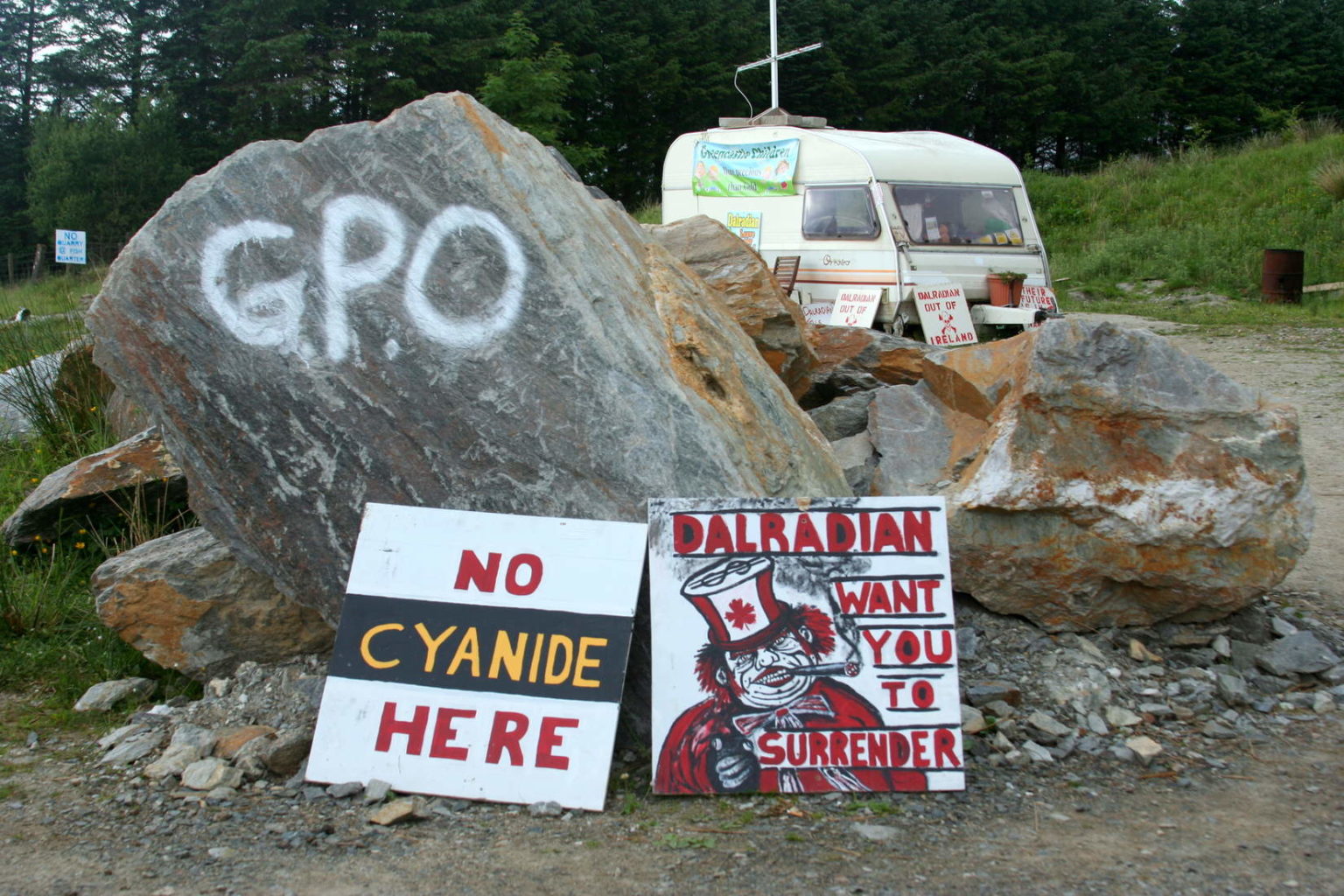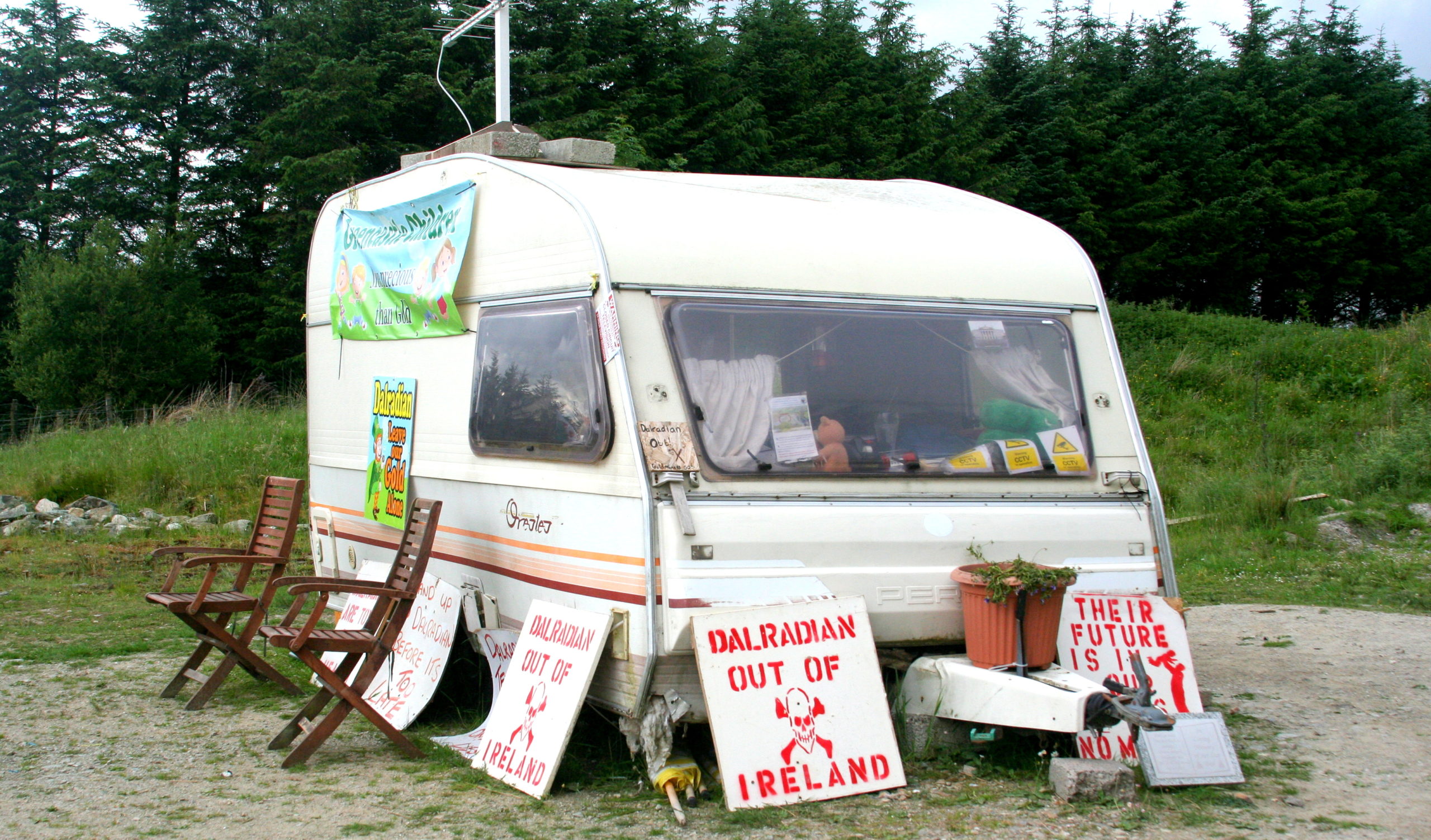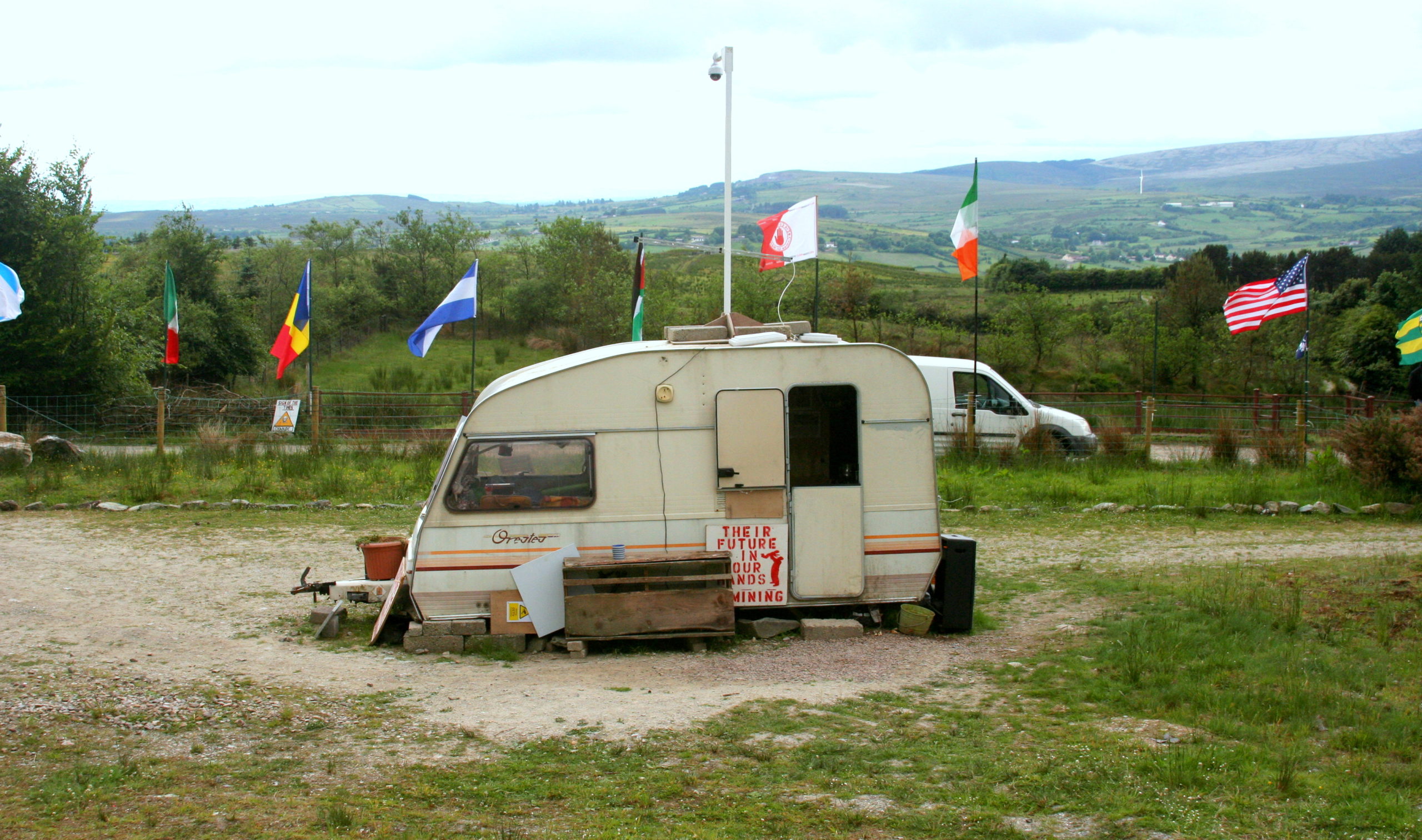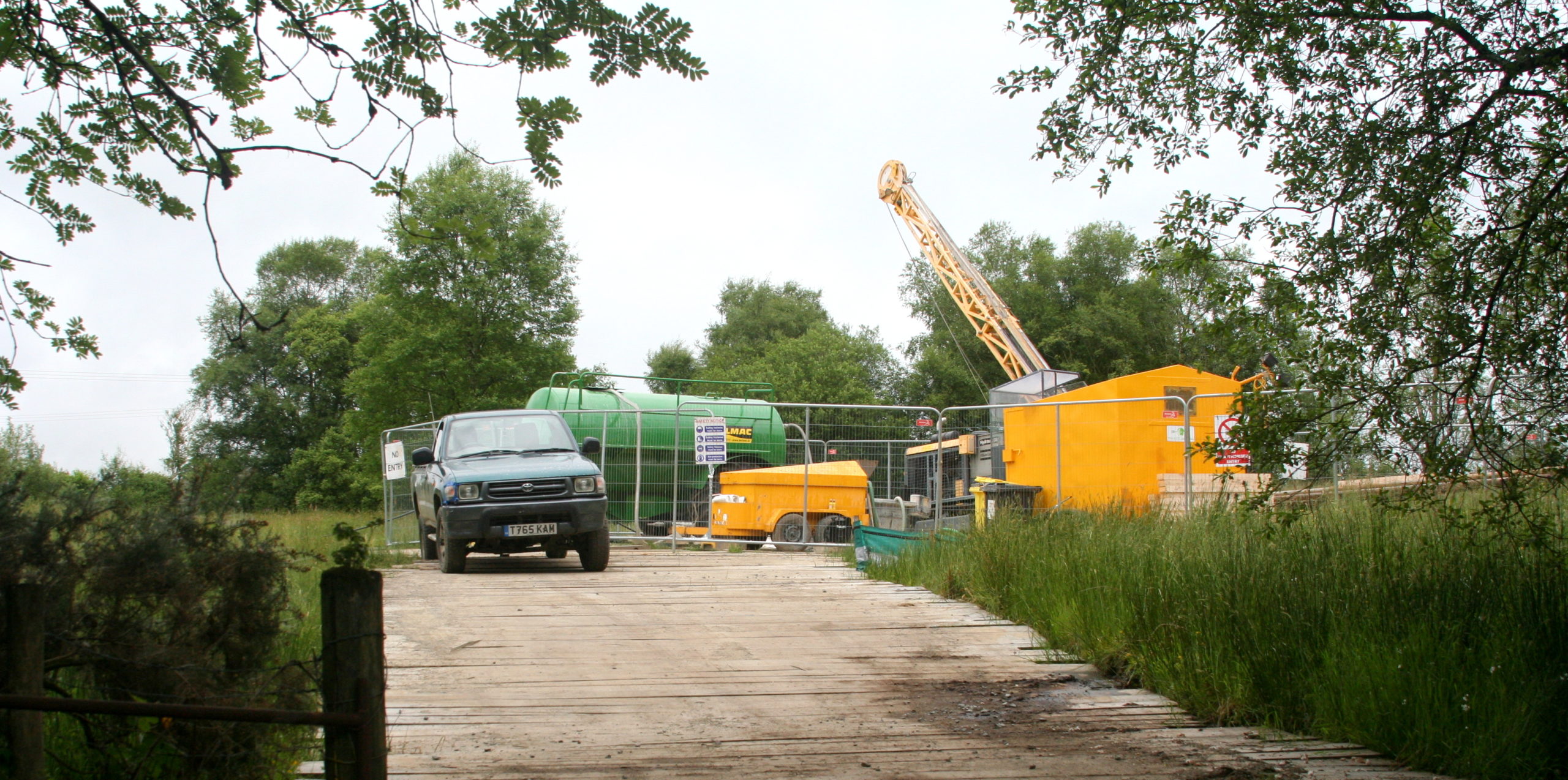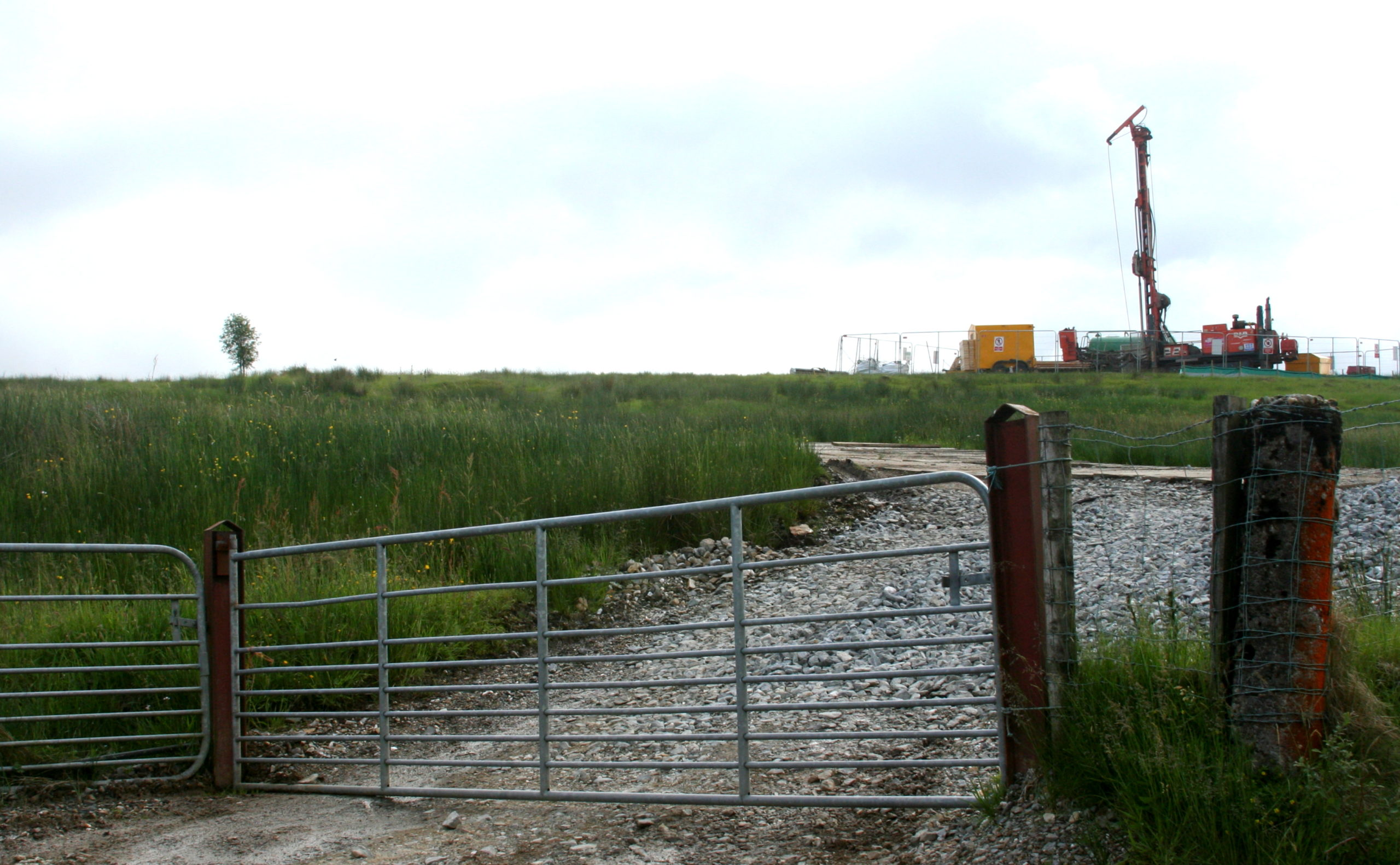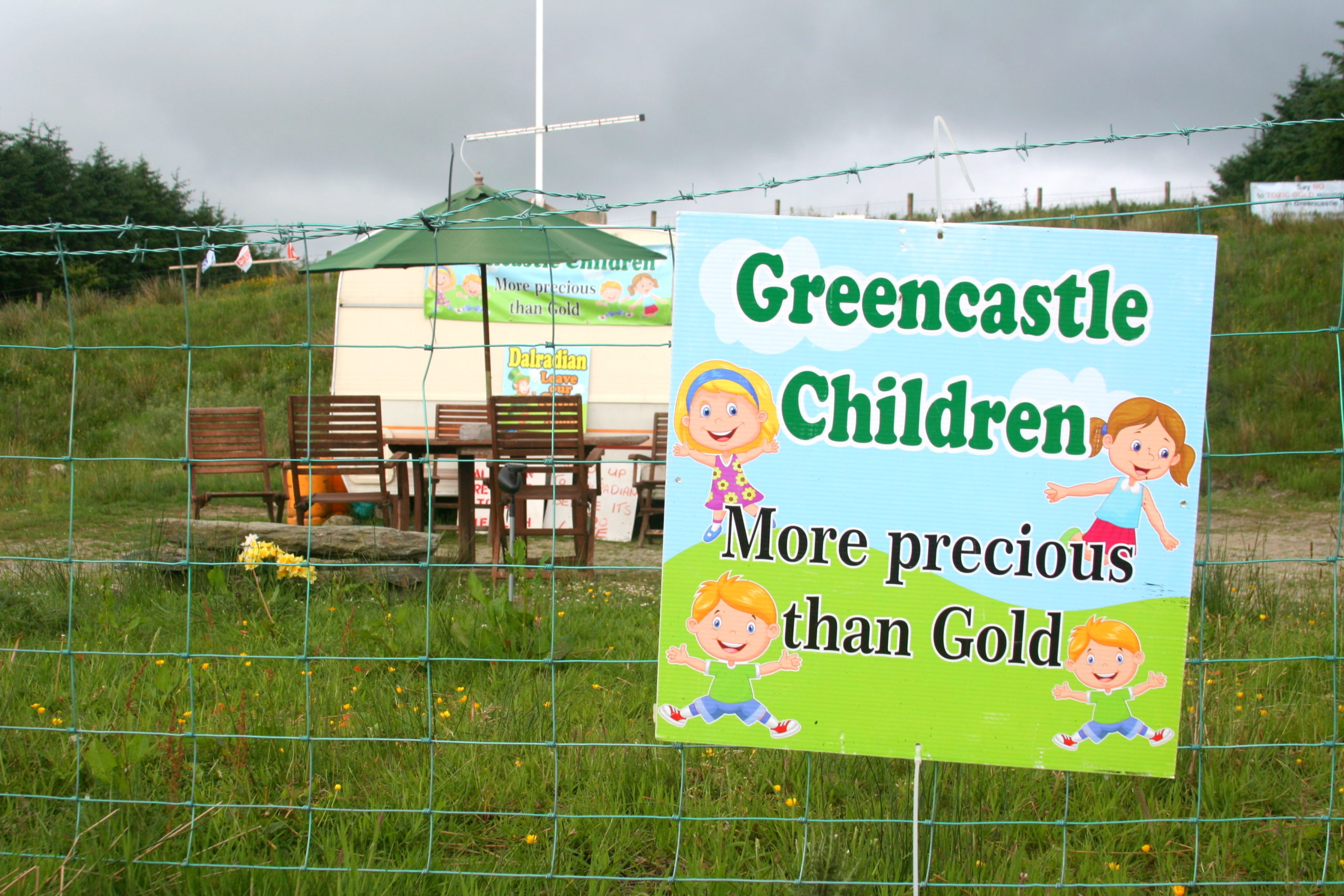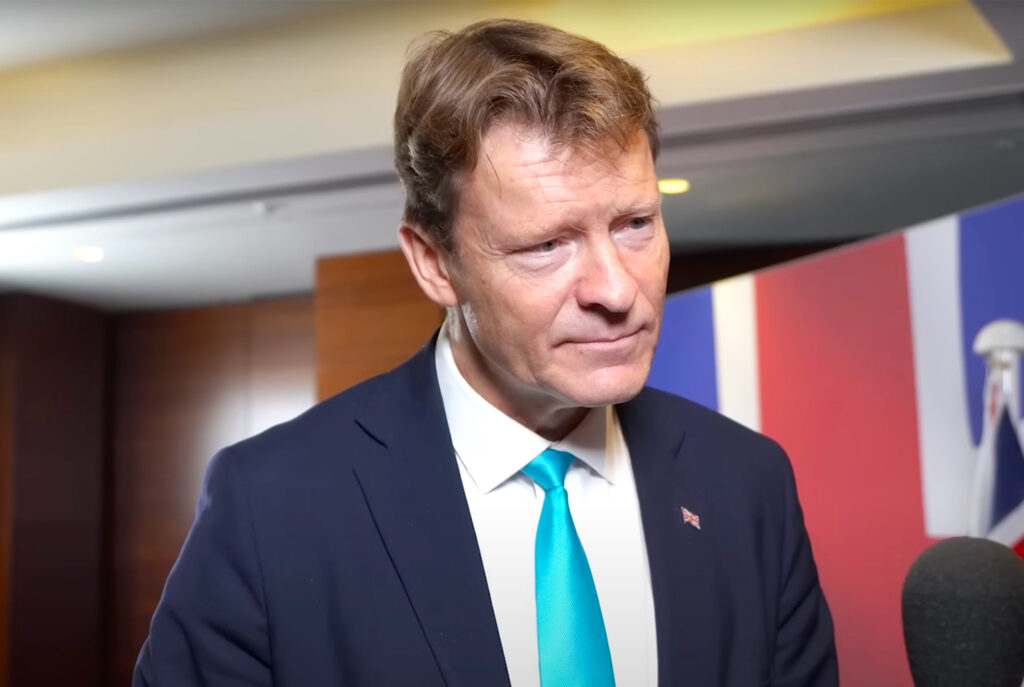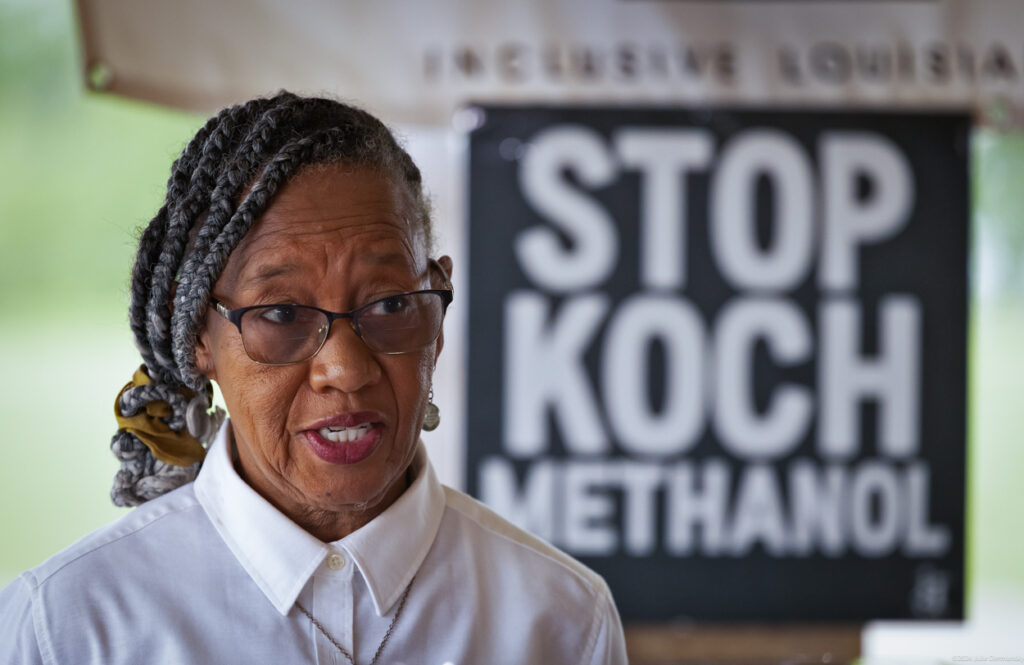As you drive up through the undulating hills near Greencastle, County Tyrone, Northern Ireland, you’ll see a sign for a local attraction: a Mass rock — not an unusual sight in this part of the world. But turn right, and in a hundred metres or so there’s something more surprising: a caravan, surrounded by a dozen or so national flags, and hand-painted signs warning of a “toxic future”.
Return to the main road, drive on a couple of minutes, and you’ll start to pass small construction sites. Normally there’s a truck or two, a yellow porta-cabin, and a few men in overalls. They stand beside a drill bore working its way into the ground, before turning their attention to you. Not engaging, but watching.
This is what it’s like living in and around the proposed site for a new gold mine as a Canadian exploration outfit, Dalradian, tests the quality of the riches beneath the earth.
The plans initially moved at a slow pace — the company has been in the region doing exploratory work since 2010. And there’s still a long way to go before the full mine gets up and running, with at least another year or so before the national government makes a final decision on the plans.
But while political support for the proposal appears to be robust, some local residents are worried.
Cyanide Processing
The cause of thier concern isn’t so much the mine itself — the surrounding area is full of quarries that scar the earth more than the closed mine would — but the plans for a new cyanide plant to accompany it. The ore in County Tyrone is relatively low grade, so it needs to be mixed with cyanide to extract the gold.
The company insists the process is entirely safe. But some local residents are concerned.
“When people heard there was cyanide coming and it was coming up here, people got scared and annoyed. And then people did research. They didn’t take it from anyone, they got online and did their research”, Cormac McAleer, one of the leaders of a small local resistance to the plans, told me.
“The ordinary people, the more they hear the more angry they get and the less they trust the powers that be. Because it seems like the Dalradian people are just saying to us, ‘everyone has their price’.”
McAleer is retired and he and his wife have been probing, questioning, and ultimately objecting to Dalradian’s plans for years. They have pushed for the release of ever more information, taking some objections through judicial review.
In November 2017, Dalradian submitted a full proposal for the mine and cyanide plant. It reportedly ran to more than 10,000 pages.
Because of the scale of the proposal, it has been deemed of national importance and so put in the hands of Belfast’s bureaucrats rather than the local council.
The Department of Infrastructure has already announced there is sufficient interest to justify a public inquiry. Dalradian told DeSmog UK it endorses this move, even though it means the plans are unlikely to accepted or rejected for more than another year, with plenty of battles to be fought along the way.
So why is there already so much local angst, if a final decision likely won’t be made any time soon?
Because local residents are concerned that, post-Brexit, their small, green, patch of Northern Ireland could become the cyanide processing capital of Europe, the campaigners told me.
There have been a number of cyanide-related disasters in the EU. At a plant in Romania in 2000, cyanide-rich waste leaked into the surrounding waterways. The disaster reportedly resulted in drinking water supplies being cut off for 2.5 million people in neighbouring Hungary and Serbia.
In 2010, the European Parliament called for cyanide processing to be banned. The European Commission is yet to back that call.
But given the UK’s supposed split from the EU in March 2019, if a ban were enacted, it would not apply in County Tyrone — meaning low grade ore could get shipped to Northern Ireland for processing.
Dalradian’s website says the company understands its environmental responsibility: “We respect the environmental heritage of the area which includes an Area of Outstanding Natural Beauty (AONB), an Area of Special Scientific Interest (ASSI) and a Special Area of Conservation (SAC). Our operations will be subject to the most stringent and rigorous regulatory standards”.
But the campaigners’ concerns are based on solid ground, according to Steven Emmerman, a retired geology professor at Utah Valley University, who has looked at the plans.
“My concern is that Dalradian is seeking to mine such a low-grade ore that they will not be able to make a profit without cutting corners on health and safety.”
“It is very difficult to keep the cyanide from leaking into the groundwater without spending a huge amount of money on safety infrastructure, which is, of course, inconsistent with trying to make a profit from a low-grade ore.”
“This kind of low-grade gold mining makes sense economically only if the company can find a way to take home the profits, while the local community suffers and pays for the environmental damage and social disruption.”
‘Dissidents’
That’s the technical reason some residents are getting organised to resist the development. But the ferocity with which they are opposing Dalridian’s presence goes much deeper. As is so often the case in this part of the island, to understand it, you have to engage with the area’s troubled past.
Over cups of tea and McVities biscuits, Sean Tracey and his brother Martin explained to me why their opposition to the plans goes so deep.
“It’s going back to the dark days for this community. And that’s not down to anything this community has done”, Martin Tracey told me.
“We went through 40 years of mental anguish. We were just getting over the whole thing. This is getting into a police state again for us. There are police in the road, there are helicopters flying overhead, there’s a policeman that comes once or twice a week.”
“Now this area in the times of the troubles was a no go area. The police didn’t come here. They had to be flown in by chinook or they had to be flown in by British Army helicopter. So we deserve the same right as anyone else in the north of Ireland to have peace in our time in relation to not having to worry about the health and wellbeing of our families, or if we go out at night what may happen to them. That’s not the case now.”
He told me he had suffered intimidation while handing out leaflets giving the campaigners’ perspective of the plans. They were doing it on a Sunday, just as people were leaving mass, “as we knew that’s when it was guaranteed to be busy”.
He told me that the caravan, because it is on a scrap of land within the boundaries of the development, means the campaigners have been characterised as “dissidents” — a loaded term in this part of the world.
“What that does is it alienates you from the protestant community, and it alienates you from middle of the road nationalists. And they can’t be seen to show support. Even though it’s women and children, fathers and uncles and brothers and aunts and wives that are manning this and doing this”.
Dalradian strongly denied any of its employees reffered to the campaigners in this way. A spokesperson for the company told DeSmog UK:
“The company has not issued any statement on the caravan that is trespassing on our lands. Neither have we referred to any people as ‘dissidents’. The company recognises that there may be differing views on mining and development and respect the rights of people to hold varying points of view. Equally, the company would ask that the views of those that support the project are respected.”
Rosemarie Shields, a local SDLP councillor for the area, agreed that the recent history of Omagh and the surrounding area plays a part in the force of feeling towards Dalradian.
All of the opponents to the proposal that I spoke to mentioned that a portion of the revenue will be paid to the Crown Estate, “which doesn’t go down too well with some people who see themselves as Irish”, Shields pointed out.
“You don’t want to see any community split, especially by an outside interest. But I guess that’s the nature of business, you know”, she said.
“This leaves an area and community that are vulnerably isolated with an awful lot to lose”.
She understands the Traceys’ anger that more politicians don’t seem to be listening and taking up the cause.
“It does seem at times that noone is listening to their concerns, and I can understand their frustration”.
“They’re up against a massive PR machine.”
It’s what they perceived as a mis-characterisation of the community that really frustrates the campaigners. Martin Tracey said it has been happening since Dalradian first arrived and ran some local events to present the company’s plans.
“They think this is just an area of welly wearing sheep farmers, so I played the welly wearing sheep farmer”.
“They took the local community for fools.”
When I first met Sean Tracey, a biomedical engineer in a local hospital for a coffee in the local Dunnes department store, he was carrying a thick black binder full of highlighted documents: maps, plans, letters and responses. But there is a downside to knowing your stuff, he told me.
“I think sometimes doing your research can be a very negative thing because it opens your eyes to the reality of the situation. The dark reality of it”.
“Before this, there was no way by any stretch of the imagination I could have been described as an environmentalist or an activist or anything else.”
“But then I see that they were basically going to run roughshod over the locals, and were spoon-feeding them absolute bull. They don’t respect the locals. You see the advertisements they run in the local papers, there’s actually some anger in as much as do you think we’re all that naive?”
Dalradian told DeSmog UK it had made significant efforts to engage the community from the outset. A spokesperson said, “at all stages of our operations we have looked to engage and communicate with all stakeholders. The company has hosted site visits for more than 1,150 people to show the underground workings and surface infrastructure, including environmental protections such as the water treatment plant.”
“The company have a Community Relations team consisting of people who live in the local area whose roles are centred on engagement with the community”.
Sean shows me newspaper clippings boasting of the new “world class mine jobs” and “$1 billion industry” that the company claims is about to come to the area. Dalradian’s website claims the project will “create over 400 well-paid jobs, across a range of skill sets, during the construction and operation phases”.
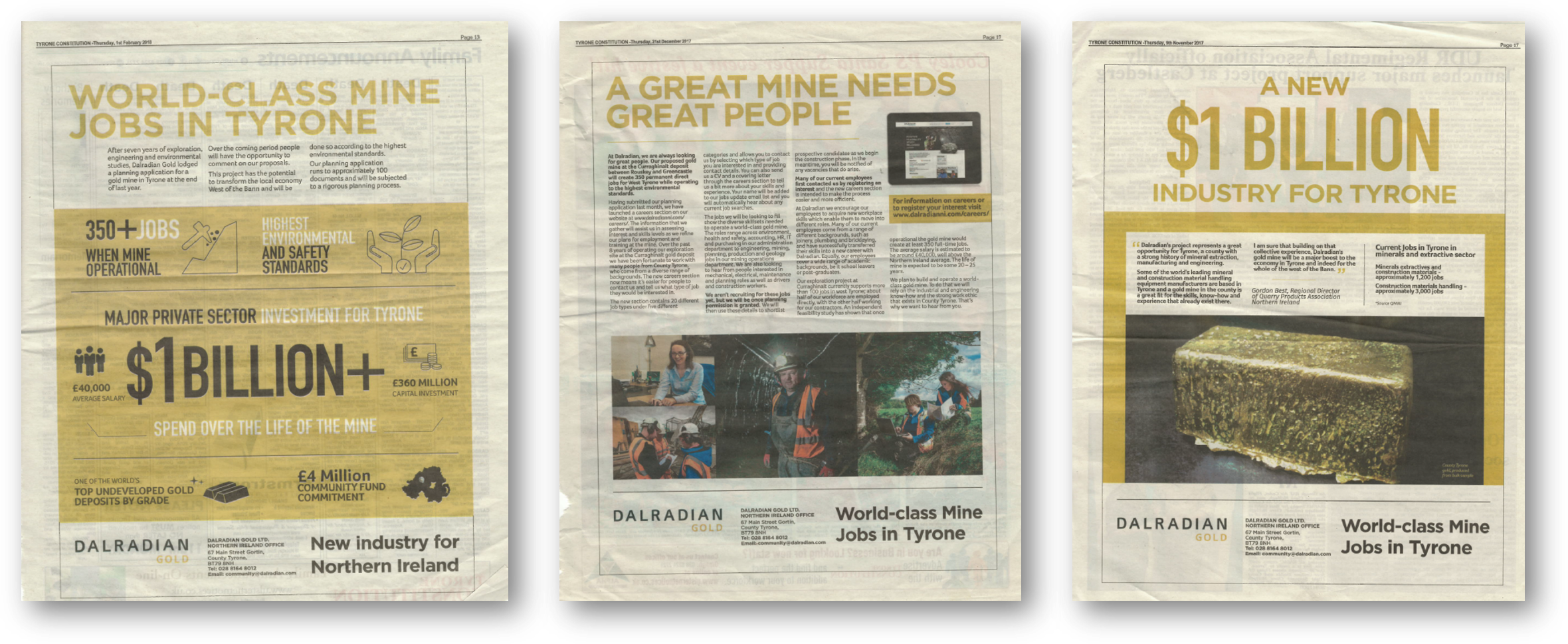
Dalradian told DeSmog UK that “the full range of jobs were communicated at a range of public consultation events and through a number of media communications. A range of skill sets will be required, with an average salary of some £40,000.”
“Our current workforce of 84 consists of many local people, including members of the management team. The company has also been working with the local college to develop training courses that will assist in growing a local workforce able to develop a world class mining operation in County Tyrone. We have stated on a number of occasions that our preference is to hire local people, in accordance with employment legislation.”
But the offer of new jobs largely misses the point, Sean argued.
“I wanted to move out of the town into the countryside because I grew up in the countryside and I wanted the same for my children. So we moved back to the country. My father owned land out there, and I just wanted a better quality of life basically. But I have to say if I had known back then what I know now, I probably wouldn’t have done it.”
“I don’t know many people who would want to live beside the only cyanide processing plant in Western Europe.”
‘Sacrificial Community’
It’s this attachment to the land, to their home, and the prospect of it being damaged that drives this group of campaigners.
“There is an Irish, native, connection to the earth”, McAleer told me. “The connection to the land is very similar to native Americans.”
He wasn’t the only person to compare their struggles to those of indigenous people across the world against major extractive industries. Martin and Sean Tracey both told me they were inspired by the Sioux at Standing Rock in Dakota, USA, as well as protesters closer to home, including the ongoing fracking resistance in Lancashire.
Martin Tracey explained how, like those communities, they now feel under siege.
“We’re generations in this land. In the whole history of this land this is an area between two of the old historical estates. So this is an area the old landlords never went to. So in days gone by there’s an old saying here — you’d retreat into the mountains. Well, now they’re trying to poison us in the mountains”.
“If this gets the go ahead, it’s just the starting point for the total decimation of the north of Ireland.”
And that’s why they’re fighting it now, at the outset, before planning permission is granted for the full development, Sean Tracey told me.
“When you see what’s going on around the world, then you see how these things can end up. If we don’t stand up and be counted right now then there’s going to be no point in 10 years time — when the thing is full blown, and you have all the social issues, the pollution issues, the infrastructure issues — there’s no point standing up then and trying to make noise about it.”
“Our community is a sacrificial community.”
Images credit: DeSmog UK CC BY–SA 2.0
Subscribe to our newsletter
Stay up to date with DeSmog news and alerts


